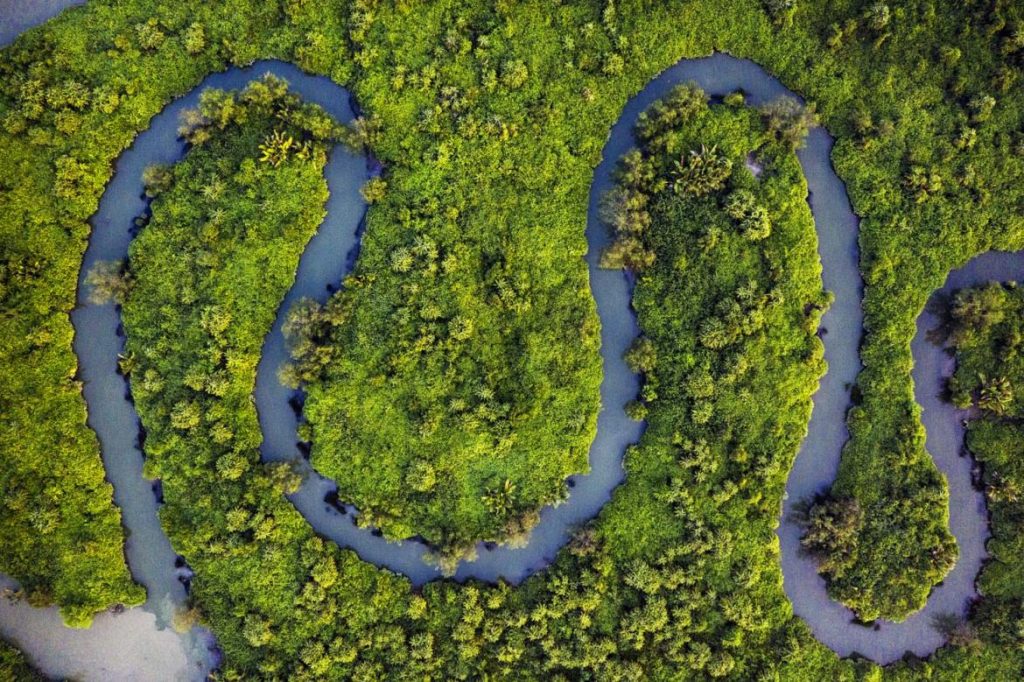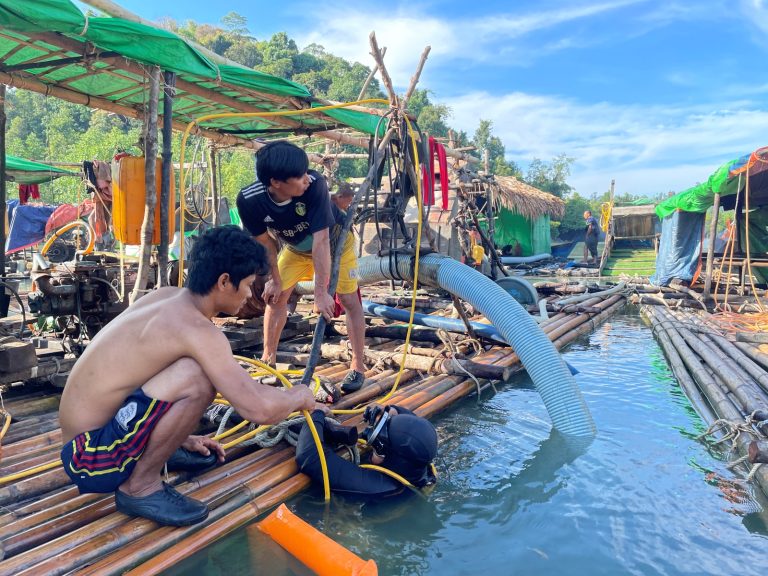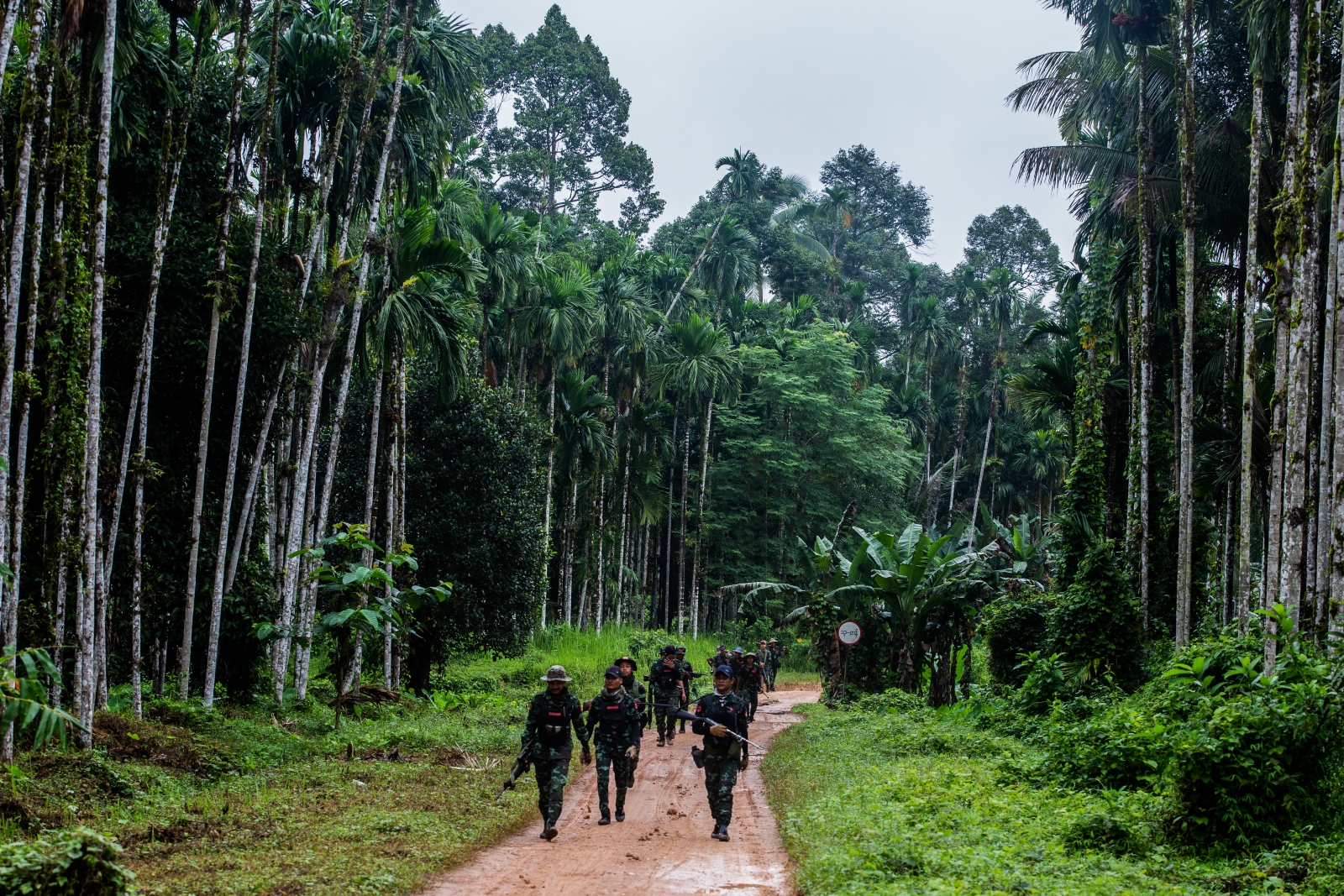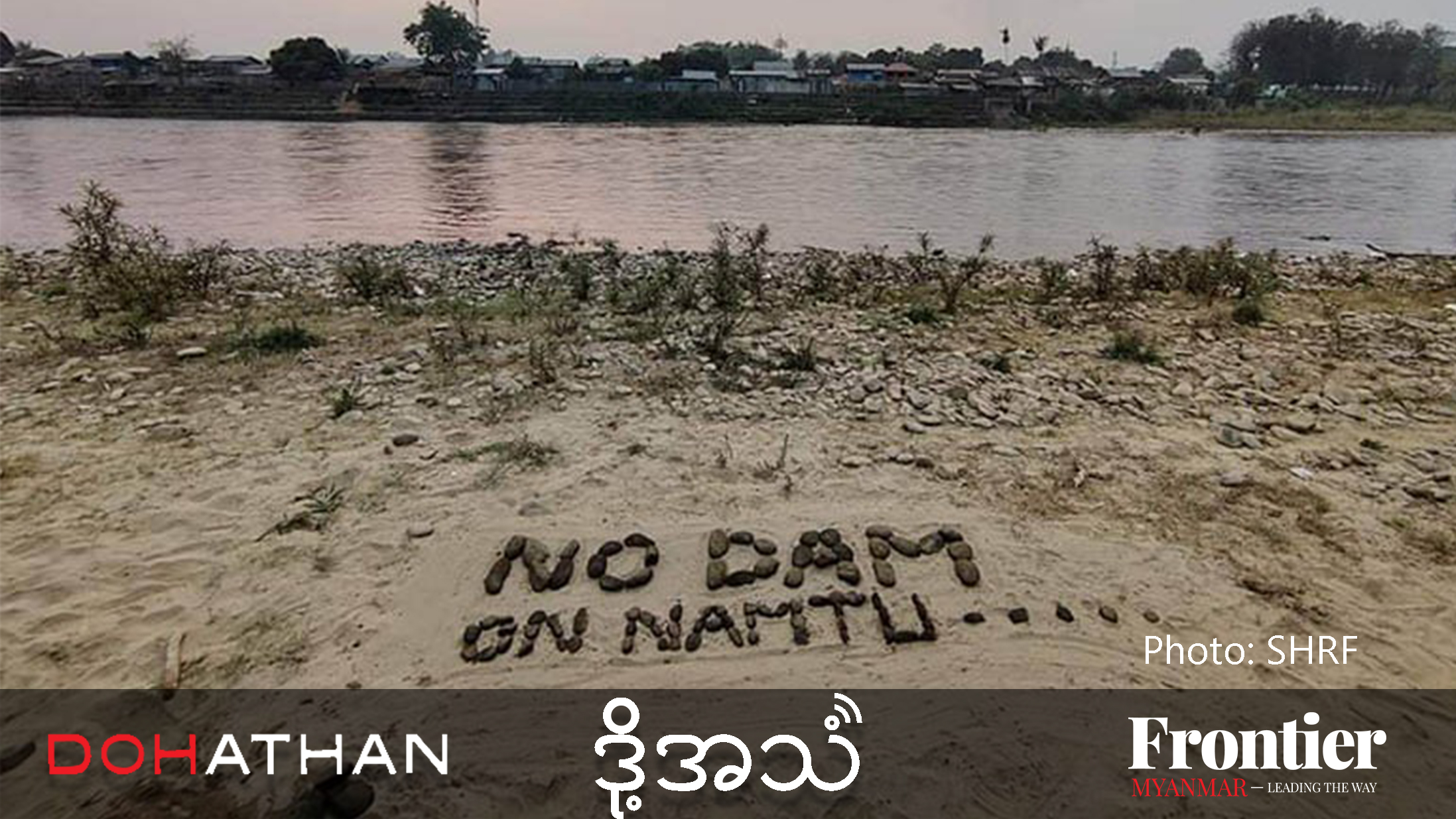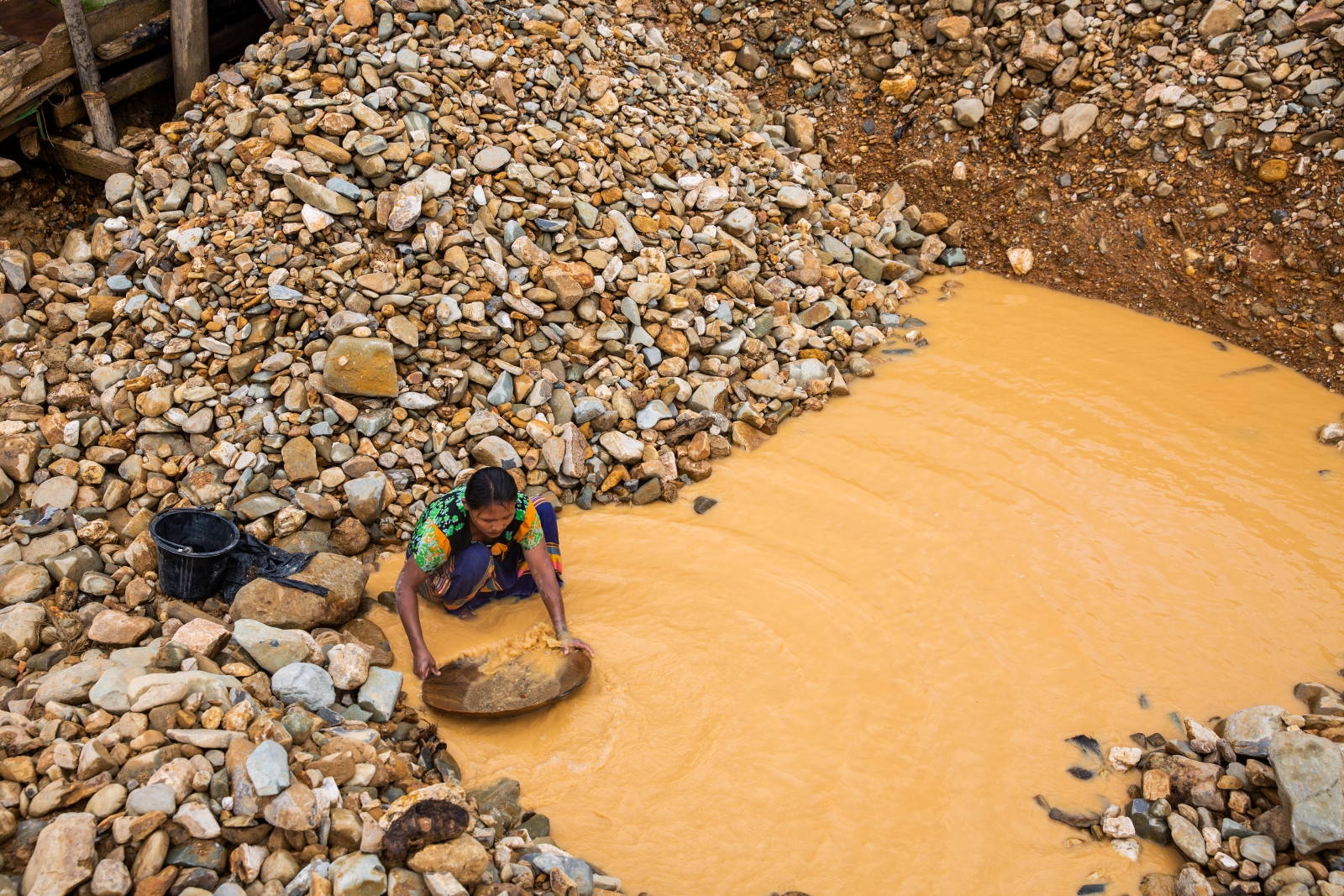On an island in the Ayeyarwady delta, saltwater crocodiles and fishing communities make unhappy neighbours, with environmental degradation driving deadly attacks.
By HEIN THAR | FRONTIER
Photos HKUN LAT
ONLY THE sound of the boat’s engine could be heard as the vessel glided along the creek on a night so dark that the four men aboard could barely see each other. They were too excited to speak.
Two of the men in the boat were using torches to peer into the darkness for a tell-tale pair of yellow shining eyes that would indicate the presence of a crocodile. Suddenly Ko Thet, who was smoking at the prow of the boat, raised his hands to signal to Ko Aye Naing to stop the engine.
“Let’s row towards him,” said Thet, pointing his torchlight in the direction of a big crocodile almost completely submerged in the water. Only its eyes and snout were visible.
As Aye Naing paddled, they stealthily approached the crocodile.
Support independent journalism in Myanmar. Sign up to be a Frontier member.
When the boat neared the animal, it sank from view. Aye Naing was worried the beast might attack, but Thet, who has 16 years’ experience as a crocodile catcher, said they did not attack big boats. Small boats were a different story, he said.
Frontier was a passenger in the boat on one of the creeks that meander through low-lying Meinmahla Kyun (island) Wildlife Sanctuary in Ayeyarwady Region’s Bogale Township.
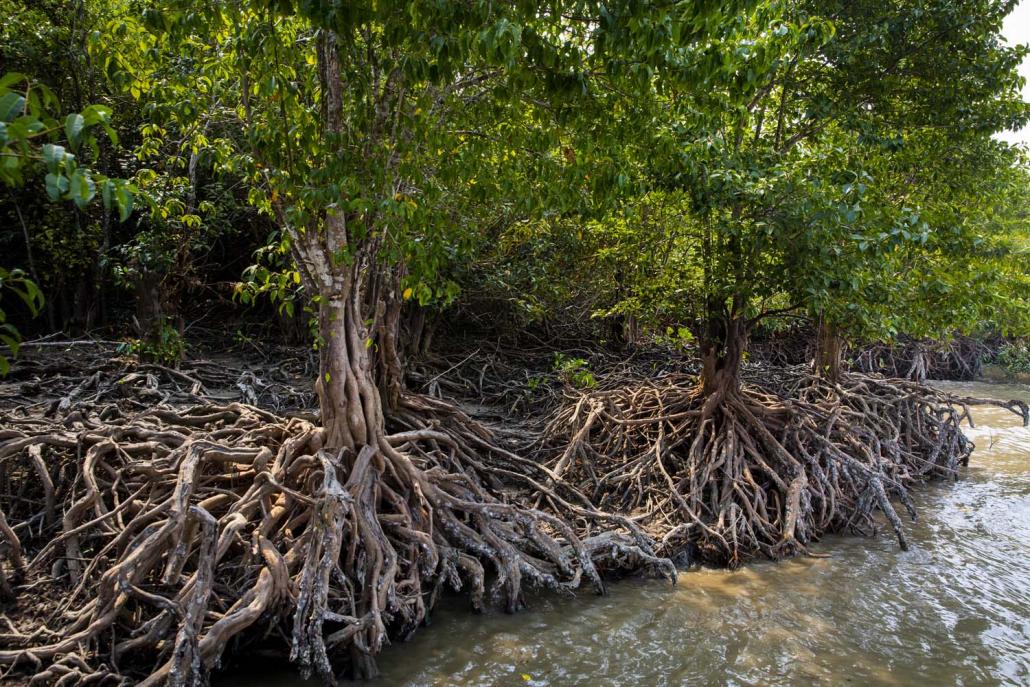
Hkun Lat | Frontier
The mangrove-covered, 13,490-hectare island, whose name means “beautiful woman”, was designated an ASEAN Heritage Park in 2003, and a Ramsar site in 2017, because of its significance as a wetland area. The wildlife sanctuary, managed by the Forest Department, is also the habitat of saltwater crocodiles (Crocodylus porosus), the most aggressive of the 13 crocodile species and the object of the nocturnal mission in the creek.
Other fauna recorded in the sanctuary includes dozens of species of birds and fish, 26 species of snakes, 12 species of shrimp, 10 species of crabs, leopard cats and Irrawaddy dolphins. The flora includes about 40 species of mangroves, 53 species of medicinal plants and 11 species of orchids.
Saltwater crocodiles, the largest living reptile, are found in coastal and estuarine waters along India’s east coast, throughout Southeast Asia and in northern Australia. The Forest Department says there were once four species of the reptiles in Myanmar but only the saltwater crocodile remains. Besides Ayeyarwady, they are also found in Tanintharyi Region.
Traditional beliefs hold that crocodiles are controlled by a powerful a nat, or spirit, known as Ah Boe, who lives on Meinmahla Kyun and is revered throughout lower Myanmar.
During the military government of General Ne Win, in 1963, the newly formed People’s Pearl and Fisheries Corporation began catching crocodiles in the Ayeyarwady delta and exporting them live or selling their skin for luxury leather products.
A parallel black market emerged and any crocodiles seized by the government from illegal smugglers were kept in the compound of the Trade Department in Yangon.
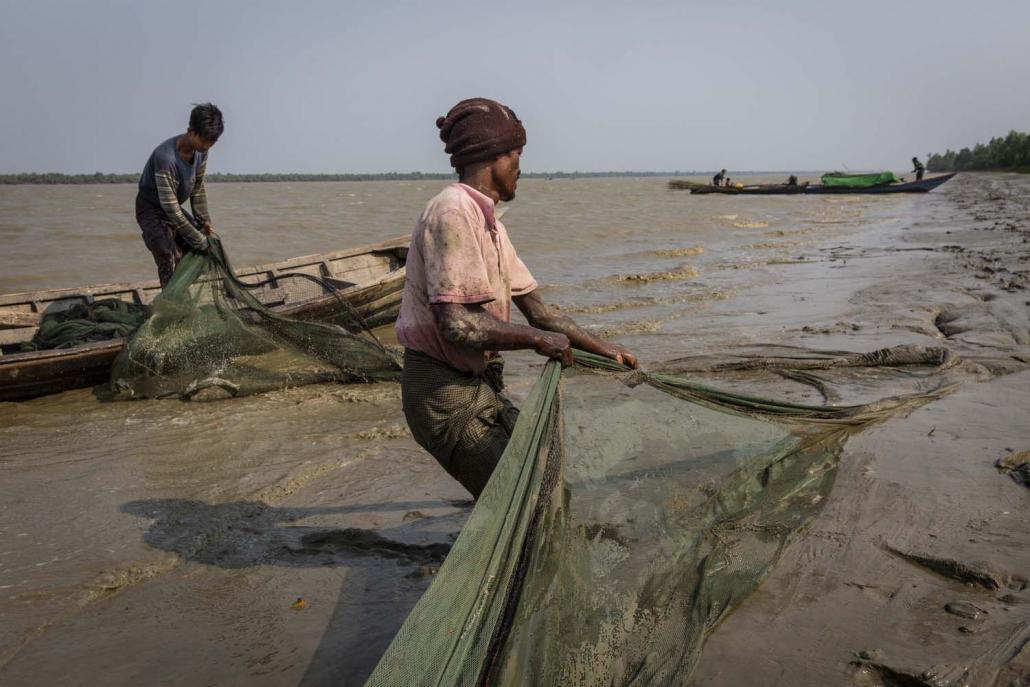
Fishers haul in nets at the edge of the Meinmahla Kyun Wildlife Sanctuary, where entry is prohibited. (Hkun Lat | Frontier)
In 1977, Ne Win visited Cambodia, then called Democratic Kampuchea, for talks with prime minister and Khmer Rouge “Brother Number One” Pol Pot. The communist dictator and genocidaire reportedly gave his Myanmar guest three crocodiles as a present. Ne Win was said to have been delighted with the gift and had a crocodile farm built at Yangon’s eastern Thaketa Township to house the three reptiles. The farm survives as a low key tourist attraction and research facility, housing more than 500 crocodiles.
Unfortunately, the three animals given by Pol Pot were killed after being put in a tank with some saltwater crocodiles that had been seized from smugglers in Myanmar.
Ne Win was angry when he heard that Pol Pot’s gifts had been killed and scolded and demoted the staff at the crocodile farm, a former People’s Pearl and Fisheries Corporation official who worked at the Thaketa enterprise told Frontier.
The former official, who works for a wildlife conservation NGO and asked not to be identified, said Ne Win had banished the demoted staff and the crocodiles that killed Pol Pot’s presents to Meinmahala Kyun. The internally exiled staff were ordered to help build up the numbers of saltwater crocodiles in the area because their population had fallen sharply as a result of continuous catching by the People’s Pearl and Fisheries Corporation.
Gradually, the number of saltwater crocodiles on the island began to recover.
In 1994, the State Law and Order Restoration Council enacted the Protection of Wildlife and Conservation of Protected Areas Law, under which crocodiles were protected and trade in the reptiles was banned. The law passed by the junta also provided the basis for Meinmahla Kyun to be maintained as a nature reserve, to which entry was prohibited. This contributed to a population explosion among the area’s crocodiles.
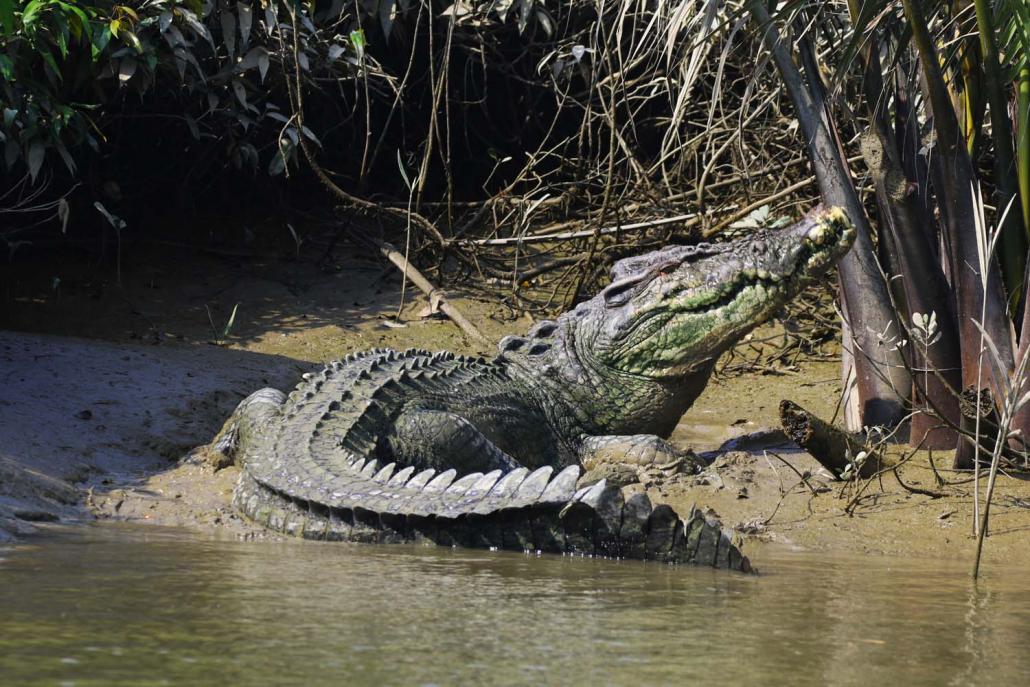
A saltwater crocodile inside the wildlife sanctuary. (Supplied)
These crocodiles found new neighbours after Cyclone Nargis roared across the Ayeyarwady delta in 2008, leaving at least 140,000 dead and devastating vast areas of farmland. Many farmers left homeless by Nargis moved to the area around Meinmahla Kyun to work as fishers.
Saltwater crocodiles are highly territorial and they regard any human in their waters as prey, so deadly encounters ensued. These have happened in the creeks of the island, which villagers enter illegally to catch fish and shrimp, but more commonly in the waterways outside of the wildlife sanctuary, where crocodiles from the island roam for food.
“People intruded into the crocodiles’ territory and so the animals attacked them,” said Ko Hla Soe Win, who has worked as a Forest Department ranger on Meinmahla Kyun since 1994. A survey in 2018 counted more than 200 crocodiles on the island.
The Bogale Township Administration Office says there are 31 fishing villages within half-an-hour’s boat ride of Meinmahla Kyun. Most of the fishers taken by crocodiles were setting shrimp and fish traps. The creatures like to drag their prey under water while performing what’s known as a “death roll”. Few survive this experience.
U Thant Zin Aung, who heads the management of the wildlife sanctuary and the township Forest Department, told Frontier there were 16 crocodile attacks in the area between 2012 and 2019, five taking place inside the wildlife sanctuary and 11 outside, closer to the villages. Ten were fatal. However, local residents believe that many attacks go unrecorded.
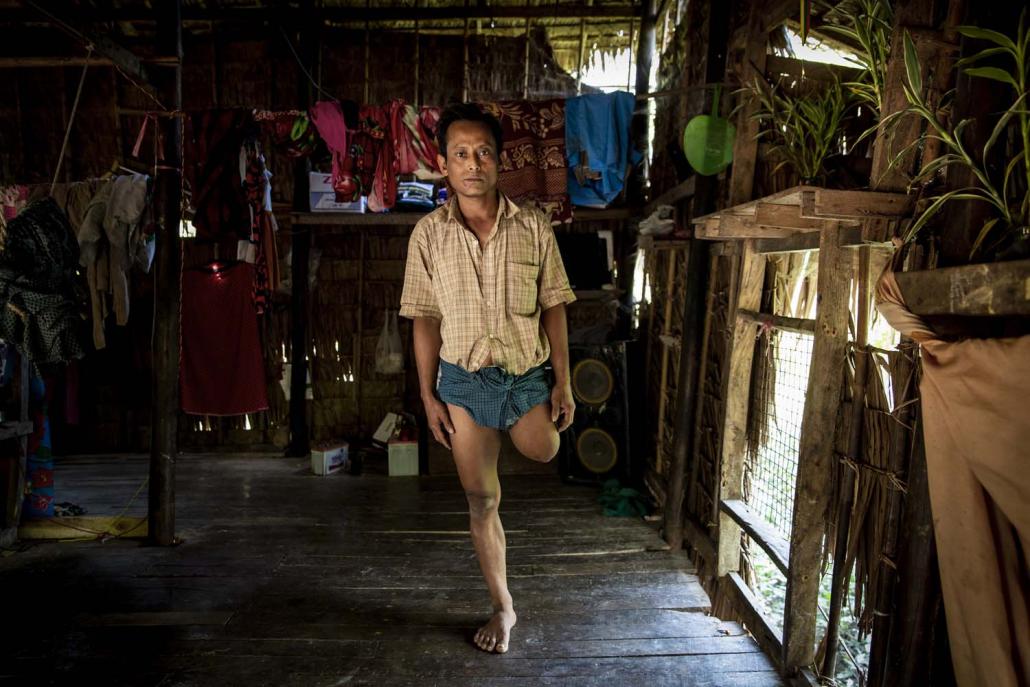
Ko Htun Win lost his left leg to a crocodile in 2018 while setting a fishing net in the waters close to his village of Wae Chaung. (Hkun Lat | Frontier)
Ko Htun Win lost his left leg to a crocodile in 2018 while setting a fishing net close to his village of Wae Chaung. His wife, who was at his side, managed to pull him back onto the boat. But after a struggle lasting an hour, the crocodile swam off with his leg in its mouth.
“I’ve become disabled and I have to depend on my wife,” Htun Win told Frontier at his home in Wae Chaung.
Htun Win’s neighbour was the victim of a crocodile attack the same year while catching crabs. The crocodile inflicted a savage wound on the man’s abdomen. The skin was sewn together to close the wound with the result that the man cannot walk straight and is bed-ridden most of the time.
Attacks like these have made people wary of going into the water.
“Some villagers cannot swim even though they live beside the river, because they are too frightened to go into the water,” said U Kyaw Win, a 100-household leader in Wae Chaung. “We’ll never be able to have secure livelihoods for as long as the crocodiles are here.”
Villagers also complain that crocodile attack victims never receive compensation from the government. The 1994 Protection of Wildlife and Conservation of Natural Areas Law says that anyone who kills a crocodile is liable to be sentenced to five years’ imprisonment.
But while crocodiles are protected under the law, it mandates no compensation for humans who are attacked. The 1994 law was replaced in 2018 by the Conservation of Biodiversity and Protected Areas Law, which also says nothing about compensation.
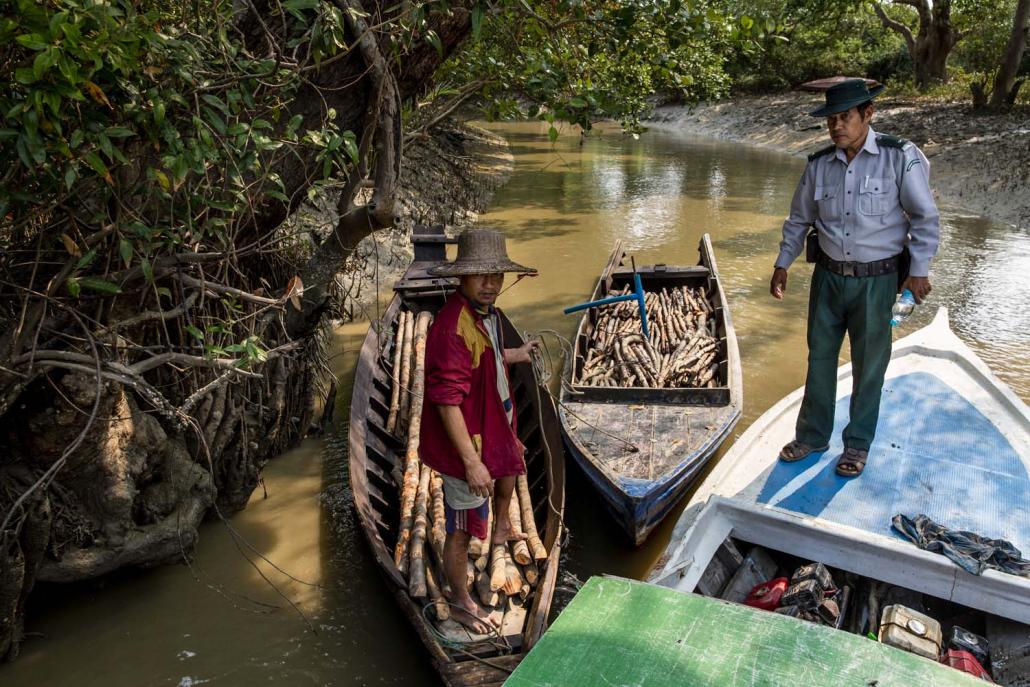
A forestry officer stands beside boats laden with illegally cut timber that were arrested during a monthly patrol in the wildlife sanctuary in late February. (Hkun Lat | Frontier)
When Htun Win was attacked, staff from the township Forest Department visited and gave him K30,000 out of pity and kindness.
“We want to hack down the crocodiles and the Forest Department staff who protect the creatures,” said Htun Win’s wife.
Her family had a decent standard of living when her husband worked as a fisher, she told Frontier, but since the crocodile attack it was struggling to live on the proceeds of their small grocery shop in Wae Chaung.
Feeling that their fears and concerns are ignored by the government, the local residents sometimes wreak bloody revenge on the giant reptiles.
In 2013, a group of villagers killed one of the biggest crocodiles on Meinmahla Kyun in a rage after it dragged a young novice monk into the water. After retrieving the boy’s lifeless body from the water, the residents of multiple villages hunted down the crocodile, who was said to be 18-feet (5.4 metres) long and known locally as arpaegyi, or “torn-off mouth”. The villagers stabbed it to death with iron spears and pointed bamboo poles, before dragging its body ashore and burning it to ashes.
Hla Soe Win, the forest ranger, said the Forest Department tried to take legal action but gave up because too many people were involved in killing the protected animal.
He said the deadly encounters were driven by the illegal plundering of the natural resources that sustain the crocodiles on the island. People from the nearby villages sneak into the wildlife sanctuary to catch fish and prawns using pesticides, he said, meaning the crocodiles are forced to roam more widely, including into village areas, in search of food.
“This happens because men cannot help their greed,” Hla Soe Win said.
Many people were fishing openly in the wildlife sanctuary during Frontier’s visit. Foresters and rangers from the Forest Department patrol the island twice a month, but have not made any arrests because offenders can easily escape, said U Bo Bo Lwin, a forester. He leads patrols, generally of half a dozen men, and admits that he cannot effectively protect an area covering 13,490ha with such a small number of officers.
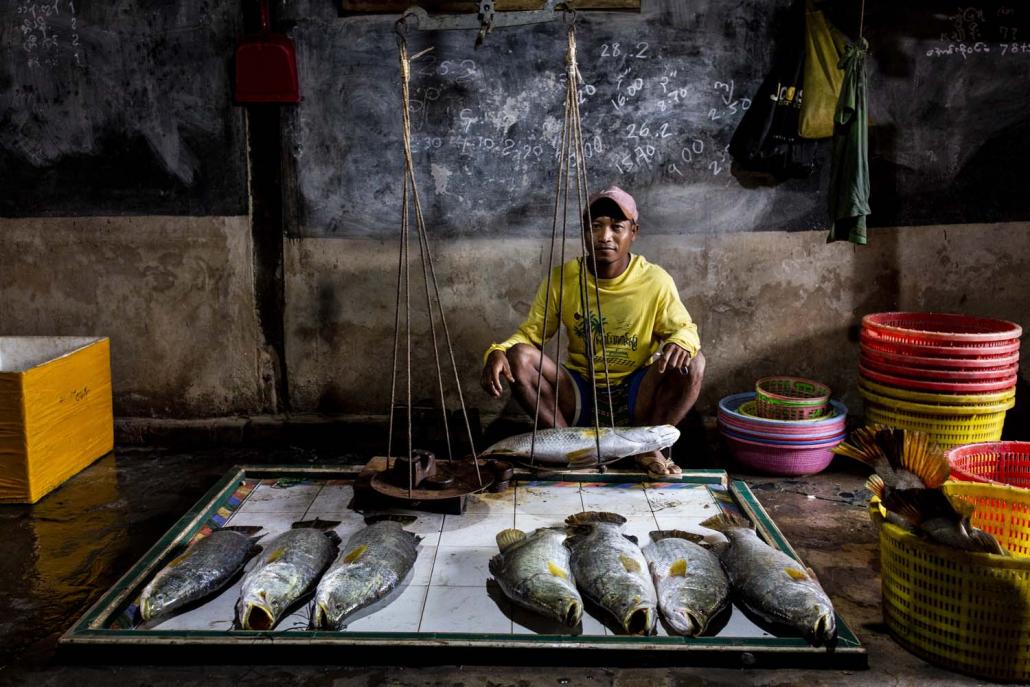
A vendor at Bogale Township’s Ka Don Ka Ni village displays fish caught illegally in the nearby Meinmahla Kyun Wildlife Sanctuary. (Hkun Lat | Frontier)
The fish, prawns and crabs poached from the island are sold at markets in Ka Don Ka Ni, a big, prosperous village south of the Meinmahla near the mouth of the delta. The catch is then transported by boat at night to the fish market in Yangon’s Kyimyindaing Township.
As well as illegal fishing, Meinmahla Kyun Wildlife Sanctuary is also being denuded of forest cover because of the illegal felling of mangroves for firewood and making charcoal.
“Illegal felling is happening every day,” said Bo Bo Lwin.
Much of the illegally felled timber is destined for Pyapon town, also in the delta, which produces about 70 percent of Myanmar’s dry fish and prawns. Large amounts of firewood are needed to process the dried seafood products.
“Illegal fellers on Meinmahla Kyun help to meet the demand for firewood in Pyapon,” said Hla Soe Win. “The forest area on the island has been greatly reduced in the past 10 years. This has damaged the ecosystem, forcing the crocodiles to leave the wildlife sanctuary in search of food, which increases the chances of encounters with humans,”
In order to reduce crocodile attacks, the Forest Department proposed at a meeting with the Minister of Natural Resources and Environmental Conservation in 2017 that an enclosure be built on Meinmahla Kyun to confine the reptiles. A source told Frontier that the minister, U Ohn Win, supported the proposal, but no enclosure has so far materialised.
Meanwhile, the commercial processing and export of crocodile skins remains off the table because it conflicts with Myanmar’s obligations under the Convention on International Trade in Endangered Species of Wild Fauna and Flora (CITES), said a senior Forest Department Official who asked not to be named.
Although the saltwater crocodile is not considered endangered, CITES prohibits the trade of the species and its by-products among wild populations, except in Australia, Indonesia and Papua New Guinea.
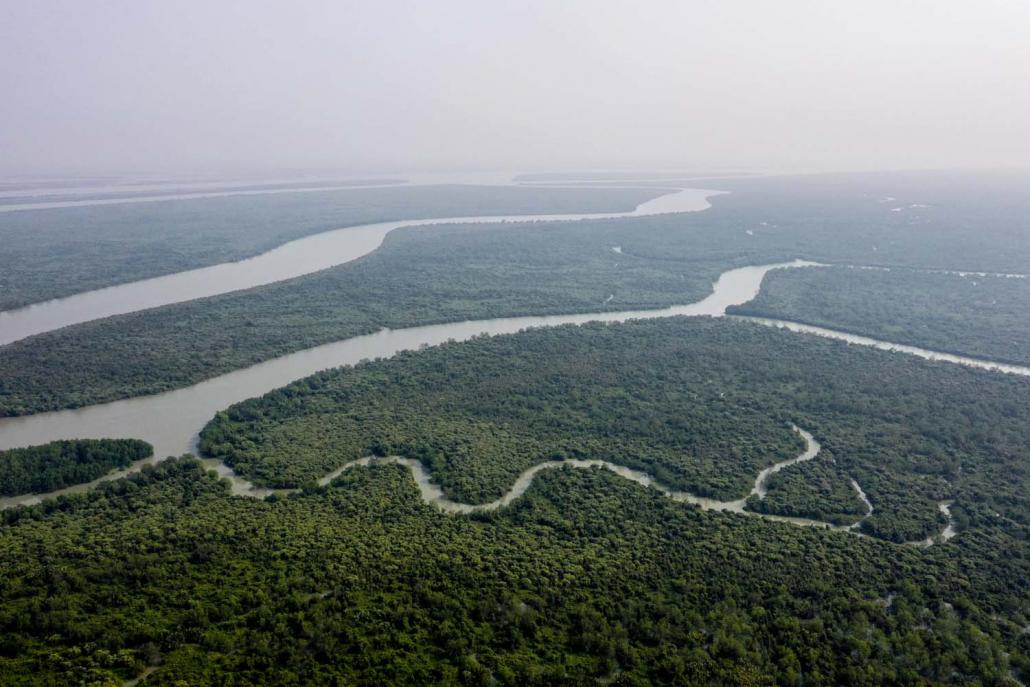
Hkun Lat | Frontier
Hla Soe, the forest ranger, says the conflict between man and crocodiles at Meinmahla Kyun would be best resolved not by building enclosures but by improving the ecosystem on the island.
He wants a reforestation programme on the island and a crackdown on those who use poisonous chemicals to catch fish. If the crocodiles have enough food in the wildlife sanctuary, they will not need to leave the island and attack humans, he said.
“If man can make compromises, the conflict with the crocodiles could be reduced,” said Hla Soe. “I want crocodiles, not men, to be the masters of Meinmahla Kyun.”


